With the Senior Bowl now in the books and just two teams — the Kansas City Chiefs and Tampa Bay Buccaneers — yet to find out their first-round draft slot, Mock Draft Season has officially begun.
This mock draft is more of a reflection of what I believe each team should do with their first-round picks rather than an exercise in trying to predict the future, which is a futile exercise if there ever was one. Still, I did try my hand at predicting several trades toward the top of the draft, namely finding a new team for Deshaun Watson and a fresh start at quarterback for the Houston Texans.
Ultimately, the first pick comes as no surprise.
1. Jacksonville Jaguars: QB Trevor Lawrence, Clemson
Not much analysis is needed here. Lawrence has been slotted into this spot for the past two years after leading Clemson to a national championship as a true freshman behind an elite 90.7 PFF grade in 2018. The only real case for someone else in this spot is boredom, as Lawrence has turned in grades of 91.0 or higher in each of the past two seasons, as well. He is as close to “NFL-ready” as you’re going to get coming out of the college ranks, and he’s the ideal player for Urban Meyer to mold his team around in Jacksonville.
2. Houston Texans (from New York): Zach Wilson, BYU
Projected trade: New York Jets trade No. 2 pick to Texans as part of Deshaun Watson trade package
The only change in Watson-related news this past week is that his assumed desire to get out of Houston became official through a trade request. And no team has a more valuable trade asset to offer the Texans than the Jets do in the second overall pick of the 2021 NFL Draft. Of course, Watson would have to approve any trade thanks to his no-trade clause, but there is reason to believe New York would have some level of appeal.
The Jets made one of the most well-received head-coaching hires of the offseason when they brought in Robert Saleh from San Francisco; they are also in a position to add pieces to their roster through free agency, as they have over $60 million in projected cap space.
On Houston’s end, they get their choice of quarterback behind Lawrence. It’s a close call between Wilson and Fields, but it’s hard not to be impressed with what Wilson did this past season at BYU. He has special arm talent and has shown the ability to improvise and create outside of structure — two things that have proven to be favorable traits in recent years. Wilson's 95.5 passing grade led all quarterbacks this past season.
3. Carolina Panthers (from Miami via Houston): QB Justin Fields, Ohio State
Projected trade: Carolina Panthers trade No. 8 pick and future picks to Miami Dolphins to move up to No. 3
Recent comments by Matt Rhule make it sound increasingly unlikely that Teddy Bridgewater will be the Panthers’ starting quarterback in 2021. If they lose out on the Watson sweepstakes, as they do in this scenario, it would make a lot of sense for them to jump ahead of Atlanta and secure one of the top three quarterbacks in this year's draft.
If you’re looking for accuracy — which every team should be — look no further than Justin Fields. No quarterback in college football was more accurate than Fields was this past season at Ohio State. His 72.4% accurate-pass rate, per PFF’s ball location charting, made him one of just two quarterbacks over 70%, joining Mac Jones of Alabama (72.0%). And unlike Jones, Fields has high-end physical tools to go along with that accuracy.
Fields’ player comparison in the PFF Draft Guide is “a smaller Cam Newton,” and here the Panthers tab him to replace Newton after a year with Bridgewater at the helm.
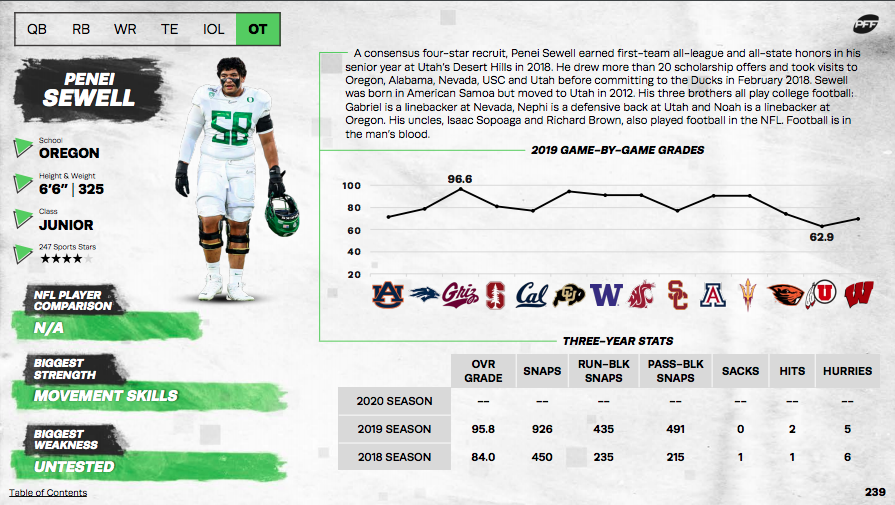
4. Atlanta Falcons: T Penei Sewell, Oregon
This is a tough spot for Atlanta with the top three quarterbacks coming off the board. But as the top non-quarterback on the PFF Big Board, Sewell is not a bad consolation prize.
Sewell didn’t play this past season for Oregon, but in all honesty, he didn’t need to after absolutely dominating competition as a 19-year-old sophomore in 2019. His 95.8 PFF grade the last time we saw him play led all FBS tackles, beating out a loaded 2020 draft class that included the likes of Tristan Wirfs, Mekhi Becton, Jedrick Wills and Andrew Thomas.
The Falcons don’t necessarily have a glaring need at tackle, but they shouldn’t pass on a player like Sewell strictly because of what they do and do not need. Kaleb McGary has recorded a pass-blocking grade below 60.0 in each of his first two seasons in the NFL, and Jake Matthews could easily become a trade candidate because Atlanta has one of the worst projected cap situations in the NFL.
5. Cincinnati Bengals: WR Ja’Marr Chase, LSU
Don’t panic, Bengals fans. Yes, Sewell is gone, but not all is lost. The thought of reuniting Joe Burrow with his top target from a historic 2019 season in Baton Rouge is appealing. The Bengals only have Tyler Boyd, Tee Higgins and Auden Tate under contract next season, and Chase would immediately step in as a true “X receiver” in this offense.
He has the speed and play strength to be a nightmare for opposing defenses to cover downfield, an area Cincinnati’s passing offense struggled in last season. In his 2019 season with LSU, Chase's 24 receptions on passes targeted 20-plus yards downfield were the most in the FBS. No other wide receiver had more than 16.
6. Philadelphia Eagles: TE Kyle Pitts, Florida
Taking a tight end in the top 10 of any draft generally isn’t the best value proposition, but Pitts is not your typical tight end. The Florida product profiles as a guy who falls closer to the Travis Kelces and Darren Wallers of the world than most receiving options at the position. Pitts’ run-blocking grade rose from 42.6 in 2019 to 65.8 this past season, as well. At just 20 years old, there is plenty of reason to believe he hasn't finished improving in the latter regard.
The writing is on the wall when it comes to Zach Ertz and his time in Philadelphia, and there is no better replacement out there this offseason than Pitts to pair with Dallas Goedert. Pitts’ offensive coordinator at Florida, Brian Johnson, joining the Eagles’ staff as a quarterbacks coach this offseason is an added bonus.
7. Detroit Lions: QB Trey Lance, North Dakota State
The Lions took back Jared Goff as part of the Matthew Stafford trade, but it’s unlikely that he is the Lions’ preferred long-term answer at the quarterback position. At the very least, he isn’t a reason to avoid taking a quarterback like Lance here in the draft.
There is legitimate concern surrounding Lance's accuracy and experience, especially since he's played just one season as a starter in the FCS, but he also has absurd arm talent and gives any team the option to lean on him in the running game. It’s a bet worth taking for Detroit as they look toward life without Stafford.

8. Miami Dolphins (from Carolina): LB Micah Parsons, Penn State
Projected trade: Carolina Panthers trade No. 8 pick and future picks to Miami Dolphins to move up to No. 3
This is not a prospect who makes a ton of sense for Miami without a trade down. Third overall is likely too early to consider Parsons, and it would be a surprise if he fell down boards to 18th overall, even with some of the off-field concerns surrounding him from his time at Penn State. However, from a fit perspective, Brian Flores’ defense is an ideal landing spot for his talents at eighth overall.
As the PFF Draft Guide says, “He’s got the type of size and skill set that could make him the first edge rusher drafted if he wanted to switch to that position.” Miami’s blitz-heavy scheme would make good use of those abilities, and that’s not all Parsons brings to the table; his downhill play against the run, athleticism and sure tackling make him one of the best off-ball linebacker prospects to come out of the college ranks in years.
9. Denver Broncos: CB Caleb Farley, Virginia Tech
Denver's cornerback room was hit hard by injuries last year. Bryce Callahan and A.J. Bouye were both limited by injuries, and Bouye sticks out as a cap-casualty candidate whose release would save the Broncos over $13 million against the 2021 cap.
Listed at 6-foot-2 and 207 pounds, Farley has the ideal build and athleticism for the position and had some of the best ball production in college football in 2019. He allowed a passer rating of just 26.8 on 50 passes into his coverage, intercepting four passes and breaking up another nine. Farley is a talented player who fills a clear area of need for Vic Fangio’s defense.
10. Dallas Cowboys: T Rashawn Slater, Northwestern
The Cowboys don’t have a glaring need at tackle, given that Tyron Smith and La’el Collins are both slated to return from injury, but as last season showed, it isn’t a bad idea for Dallas to add depth to their offensive line. Teams may have concerns about Slater’s size and length outside, but his tape against Chase Young showed that he could hold up against talented edge rushers at tackle. Slater allowed just five pressures over the entire 2019 season.
Slater would serve as an insurance policy for the Cowboys and the oft-injured Smith. He has the flexibility to play inside at guard, too, if that’s his quickest path to the field. After the 2020 season, depth at the tackle position would be a welcome sight in Dallas.
11. New York Giants: WR Devonta Smith, Alabama
The Giants likely went into the 2020 season feeling content with their offensive weapons and made no real moves to add to their receiving corps. It’s hard to imagine that being the case again in 2021, so Smith falling to 11th overall would be an ideal situation for New York.
Smith's production has been off the charts over the last two years. He led all Alabama wide receivers — a group that included three other first-round talents — in receiving yardage in 2019 and is coming off an even better, Heisman-winning campaign this past season. From his releases to his ball skills, there is a lot to like with Smith, and he would give a much-needed injection of talent to the Giants’ offense.
12. San Francisco 49ers: CB Patrick Surtain II, Alabama
From a technical standpoint, there isn’t a better cornerback in the draft class than Surtain, and that technique led to a strong resume after three years as a starter at Alabama. Surtain allowed a passer rating of 68.7 on 156 throws into his coverage across those three seasons, all while earning a 92.9 coverage grade.
A quick look through the cornerbacks on PFF’s free agency rankings page quickly tells you that there is a lot of uncertainty at the position for San Francisco, with Richard Sherman, Jason Verrett and K’Waun Williams all hitting free agency. Adding Surtain through the draft gives the 49ers flexibility in the case that some of those guys don’t return.
13. Los Angeles Chargers: T Christian Darrisaw, Virginia Tech
The Chargers are once again in a position where offensive line is one of the team's biggest needs. In particular, a left tackle spot that was manned by Sam Tevi (54.2 PFF grade) in 2020 could use an upgrade.
Darrisaw was one of the biggest risers at the position in 2020, improving his overall grade from 80.3 in 2019 to 95.6 this past season at Virginia Tech. He was tremendous in the run game and went all season without allowing a hit or sack in pass protection.
14. Minnesota Vikings: EDGE Kwity Paye, Michigan
Danielle Hunter’s recent absence has highlighted that the Vikings could stand to add a few pass-rushers to complement him. Minnesota’s 22% pressure rate in 2020 ranked dead last in the NFL.
Paye fits the bill and might just be the biggest physical freak in an edge draft class loaded with ridiculous athletes. He was No. 1 on Bruce Feldman’s Freaks List thanks in part to a sub-6.4-second three-cone at 270 pounds. His PFF grade has only improved each season at Michigan, and there is still plenty of room for growth as he adds more pass-rushing moves to his repertoire.
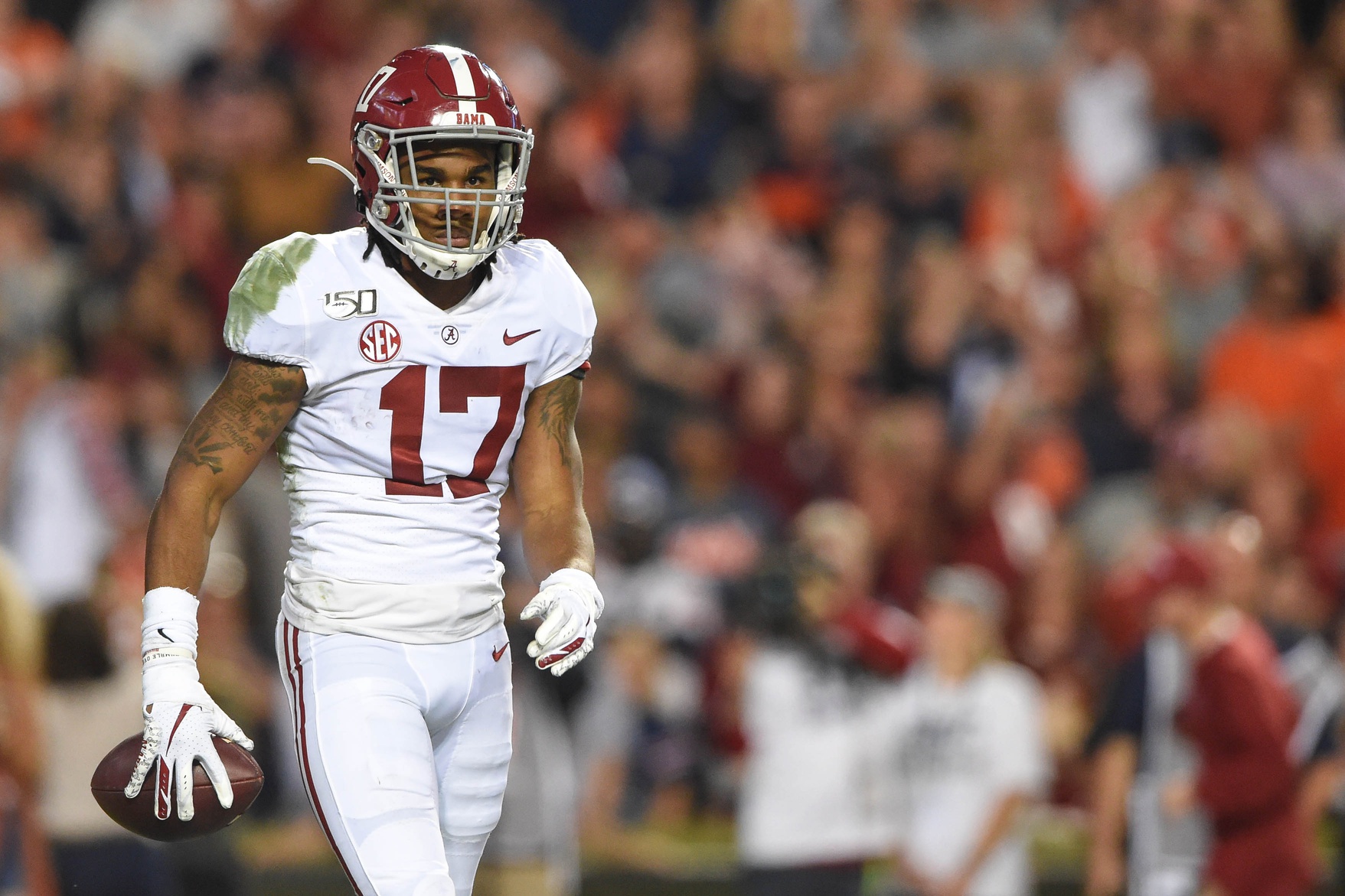
15. New England Patriots: WR Jaylen Waddle, Alabama
If there is one thing that the Patriots offense desperately needs, it is game-changing speed. Waddle provides that. It’s not just the speed that makes him so intriguing as a prospect, though. His biggest strength in the PFF Draft Guide is his “twitch,” making him all the more difficult to get a hand on in the open field.
We likely wouldn’t even be talking about Waddle at this portion of the draft if he hadn’t gotten injured last year. In the four games he and Devonta Smith played together this season before the national championship game, Waddle actually outgained Smith, 557 yards to 483, all while averaging 4.7 yards per route run. He’s the kind of dynamic receiving threat the Patriots have been without for the past several seasons.
16. Arizona Cardinals: DI Christian Barmore, Alabama
The Cardinals had seven different interior defenders play at least 150 defensive snaps last season, and the highest PFF grade from that group came courtesy of Corey Peters at 61.4. It should be a position that Arizona looks to upgrade, and Barmore is the clear-cut top interior defensive line prospect in the 2021 NFL Draft.
Barmore showed in the playoff games against Notre Dame and Ohio State why that is the case. He produced five-plus pressures in both games and looked unblockable at times against two good offensive lines. From build to flexibility to hand usage, Barmore has the tools necessary to be an impressive pass-rusher at the next level.
17. Las Vegas Raiders: EDGE Gregory Rousseau, Miami
Rousseau, like several edge rushers at the top of this class, requires a fair bit of projection after starting just one year at Miami and opting out of the 2020 season. Still, he has rare physical tools that simply don’t come around all that often. Listed at 6-foot-7 and 265 pounds, Rousseau can play both inside and outside. He recorded 17 pressures on 86 pass-rushing snaps (19.8% pressure rate) at Miami in 2019 when lined up directly over or in between the tackles.
That versatility should be appealing to Gus Bradley as he takes over a defense that could use pass-rushing help across the defensive line. In his introductory press conference, Bradley stated, “I know really where it all starts is up front. I think that’s first and foremost — to get things right up front and then fill it in everywhere else.” Rousseau gives him a piece to try and do just that.
18. Miami Dolphins: WR Rashod Bateman, Minnesota
Dolphins fans might be upset that they didn’t go wide receiver with their first pick after trading down — particularly with Devonta Smith still on the board — but coming out of the first round with both Micah Parsons and Bateman would not be a bad way for things to shake out.
Bateman has shown the ability to win both outside and in the slot over the past two seasons, playing almost exclusively outside in 2019 before lining up in the slot on over 50% of his offensive snaps this past season. His release packages and route-running ability are NFL-ready, as well. He should be able to step in as an immediate contributor as the Dolphins look to make life easier on Tua Tagovailoa in his second season.
19. Washington Football Team: QB Mac Jones, Alabama
The Football Team has two options: they can try to upgrade the quarterback position with a veteran through a trade or free agency, or they can take a shot on a player like Jones if he falls to them at 19th overall. Of course, the Jones route comes with the added benefit of a rookie contract, which would allow Washington to continue fleshing out the remainder of the roster.
From a pure production standpoint, there is a strong argument to be made that Jones should go higher than this, and he very well could. His 95.8 PFF grade this past season was nearly five points higher than any grade Tua Tagovailoa recorded in a single season while at Alabama, and Jones was one of the most accurate quarterbacks in the nation.
The concerns are about his ceiling and how much of his success owes to his situation on an absurdly talented offense while at Alabama. Still, there is reason to believe he can be an above-average starting quarterback in the right environment — an extremely valuable outcome for a quarterback on a rookie deal.
20. Chicago Bears: T Sam Cosmi, Texas
The tackle positions currently manned by Charles Leno Jr. and Bobby Massie could both stand to be upgraded, and Cosmi stands out as a strong option to do just that in a deep offensive line class.
Cosmi logged three seasons as a starting tackle for Texas — his first at right tackle in 2018 followed by two seasons at left tackle — and he improved both as a pass-protector and run-blocker in each season with the Longhorns. This past year, Cosmi allowed just eight pressures across 300 pass-blocking snaps while not picking up a single penalty.
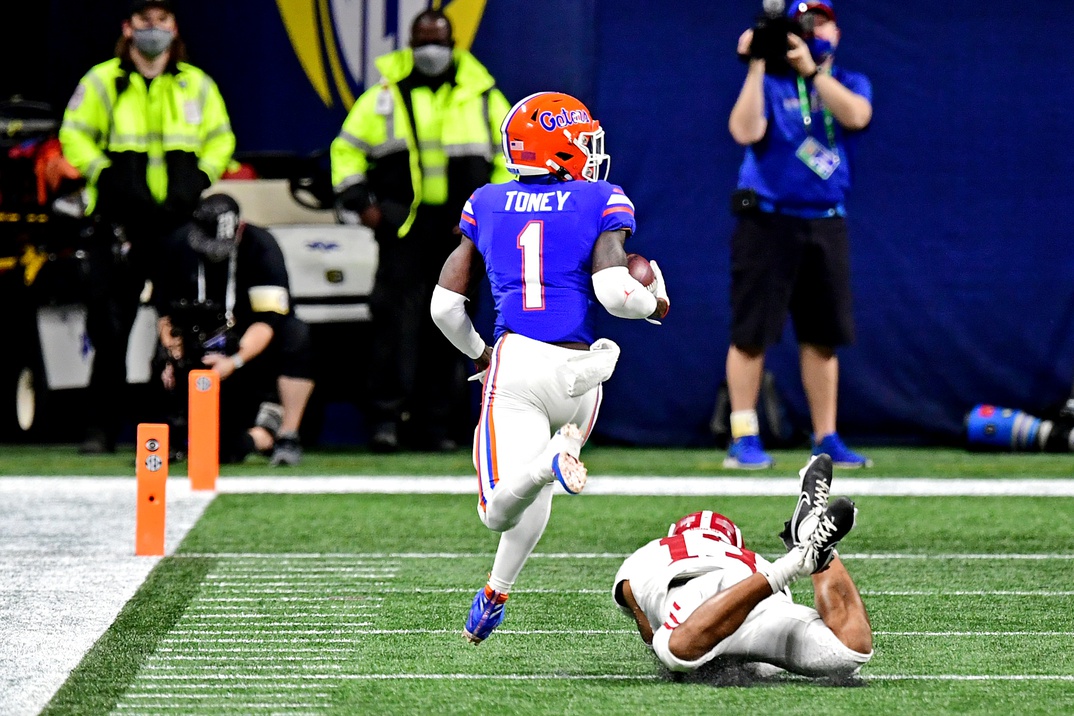
21. Indianapolis Colts: WR Kadarius Toney, Florida
The more glaring needs on offense for Indianapolis are at quarterback and left tackle following the retirement of Philip Rivers and Anthony Castonzo, but continuing to add playmakers should be high in the list of priorities for the Colts, as well. Toney certainly fits that bill.
He isn’t a finished product at wide receiver after serving primarily as a gadget player earlier in his Florida career, but he has all the traits that lead you to believe that he can develop into a polished route-runner. However, you’re drafting Toney for how freakishly elusive he is in the open field, which is highlighted by his 32 broken tackles on 80 catches since 2019. He would give the Colts’ receiving corps some extra juice in an offseason where 31-year-old T.Y. Hilton is scheduled to hit free agency.
22. Tennessee Titans: EDGE Azeez Ojulari, Georgia
Ojulari saved his best for last, earning a 94.0 pass-rushing grade in Georgia’s bowl game against Cincinnati. Using his speed to turn the corner on offensive tackles is something that repeatedly popped on his 2020 tape, but he didn’t get by on athleticism alone. Ojulari’s timing and pass-rush plan were listed as “pros” in the PFF Draft Guide.
His pass-rushing ability would be a welcome sight for a Tennessee defense that struggled to pressure the quarterback this past season. The only player on their roster with a pressure rate north of 10% was free-agent-to-be Jadeveon Clowney.
23. Houston Texans (from New York via Seattle): Tyson Campbell, Georgia
Projected trade: New York Jets trade the 23rd overall pick to Texans as part of Deshaun Watson trade package
Only four teams allowed more yards per pass play than the Texans did in 2020, and their lack of quality starters at the cornerback position was a big contributing factor. Campbell can help change that.
The former five-star recruit has the kind of length and tackling ability that should play well in Lovie Smith’s Cover 2-heavy defense, and there is certainly a ceiling there for a team like Houston — set to start on a rebuild — to chase. Campbell has graded much better in zone coverage than man coverage across his three seasons at Georgia.
24. Pittsburgh Steelers: T Teven Jenkins, Oklahoma State
Pittsburgh once had one of the best offensive lines in the NFL, but needs have quickly popped up across the line. If nothing else, the addition of Jenkins here would help kickstart a running game that was nonexistent in 2020. Jenkins’ 93.6 run-blocking grade this past year at Oklahoma State was no joke — he’s a strong man who can impose his will in the run game.
Jenkins could slide in at either tackle spot for the Steelers, as Alejandro Villanueva is set to hit free agency and there is no entrenched starter at the right tackle spot heading into 2021. While Jenkins played most of his Oklahoma State career at right tackle, he did log nearly 500 snaps on the left side, as well.
25. Jacksonville Jaguars (from L.A. Rams): Jaycee Horn, South Carolina
Jacksonville makes it two consecutive years selecting a first-round cornerback, pairing Horn with 2019 first-round pick C.J. Henderson. Like Henderson, Horn projects well as a man-coverage cornerback in the NFL.
Horn’s physicality differentiates him from the rest of this class. He gets into receivers and was one of the most productive cornerbacks in college football at the catch point. In seven games this past season with South Carolina, he allowed just eight receptions for 116 yards. You’re not going to see too many better stat lines in coverage than that.
26. Cleveland Browns: LB Jeremiah Owusu-Koromoah, Notre Dame
Owusu-Koramoah is not your traditional linebacker, at 215 pounds, but his versatility will give his defensive coordinator at the next level — Joe Woods, in this case — a lot of flexibility. He showed he could handle himself in coverage in the slot at Notre Dame while also holding up between the tackles thanks to his explosiveness. His 82.8 coverage grade on over 200 snaps in the slot this past season at Notre Dame is not something you see very often from a linebacker. It’s the type of skill set a defense like Cleveland could use.
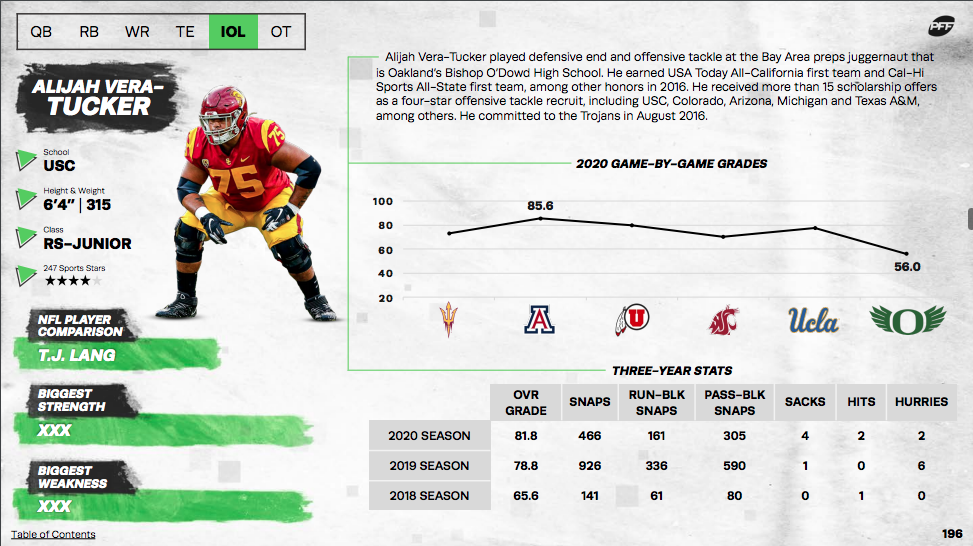
27. Baltimore Ravens: G/T Alijah Vera-Tucker, USC
Vera-Tucker graded out well in 2020 at left tackle — earning an 81.8 PFF grade — but he’s still likely better suited to playing guard in the NFL. That works just fine for the Ravens, who could stand to upgrade their offensive line's interior one year removed from Marshal Yanda’s retirement.
Vera-Tucker’s positional versatility and the potential to play tackle in the NFL is an added bonus for a team like Baltimore, as Orlando Brown Jr.’s future with the team remains uncertain heading into next season.
28. New Orleans Saints: WR Rondale Moore, Purdue
Injuries have limited Moore to fewer than 200 offensive snaps in each of the past two seasons, but his 2018 season was good enough to warrant him sticking around in the first-round conversation. As a freshman that year, Moore forced 37 missed tackles on his 114 receptions, averaging nearly eight yards after the catch per reception. It’s really as simple as getting the ball in his hands and letting him go to work.
Emmanuel Sanders could become a cap casualty in New Orleans this offseason, but even if he isn’t, the Saints should still look to add to their receiving corps with a player like Moore.
29. Green Bay Packers: LB Nick Bolton, Missouri
Bolton isn’t going to win any awards for his athleticism, but the guy brings the heat. He totaled 98 stops — or tackles categorized as “wins” for the defense — over the past two seasons at Missouri and has some of the best instincts you’ll see at the position. That allowed him to record two interceptions and eight pass breakups on just 29 targets in 2019 despite lacking high-end athleticism.
While Green Bay would love to add a receiver here, there isn’t a ton of value on the board, and linebacker remains a need after the team let Blake Martinez walk in free agency last offseason.
30. Buffalo Bills: EDGE Jayson Oweh, Penn State
The Bills added A.J. Epenesa in the second round of last year’s draft, but their best pass-rusher — Jerry Hughes — will be 33 years old next season and on the last year of his contract. Across from him, Mario Addison is also pushing into his 30s. Oweh would add some much-needed youth to the position.
You aren’t a two-time member of Bruce Feldman’s Freaks List without having some serious athletic ability, and Oweh certainly has that. He can beat tackles around the edge with his get-off, and he was much improved against the run this past season at Penn State, posting an 89.7 run-defense grade.
31. Tampa Bay Buccaneers: T Alex Leatherwood, Alabama
The Buccaneers don’t have many glaring needs, but tackle could become one if Tampa Bay decides against bringing back Donovan Smith. Even if Smith remains with the Buccaneers, a player like Leatherwood would add depth to an offensive line that still needs to hold up and keep Tom Brady protected when injuries hit.
Leatherwood would fit nicely on a Tampa Bay offensive line that already features several maulers, as he does his best work in close confines thanks to his length and strength. A three-year starter at Alabama, he improved his PFF grade each season with the team to a mark of 80.7 in 2020.
32. Kansas City Chiefs: S Trevon Moehrig, TCU
Moehrig’s versatility and playmaking ability would be a welcome addition to Steve Spagnuolo’s defense in Kansas City, even if safety doesn’t stick out as one of the team’s biggest needs heading into the offseason. Moehrig’s 20 pass breakups over the past two seasons are seven more than any other FBS safety.
Ideally, he would take free-agent-to-be Daniel Sorensen’s snaps (48.0 PFF grade through AFC championship game) in the defense and serve as an upgrade in that role. Sorensen played 150-plus snaps in the box, slot and free safety alignments this season for a Chiefs defense that does a good job of mixing up their coverages.
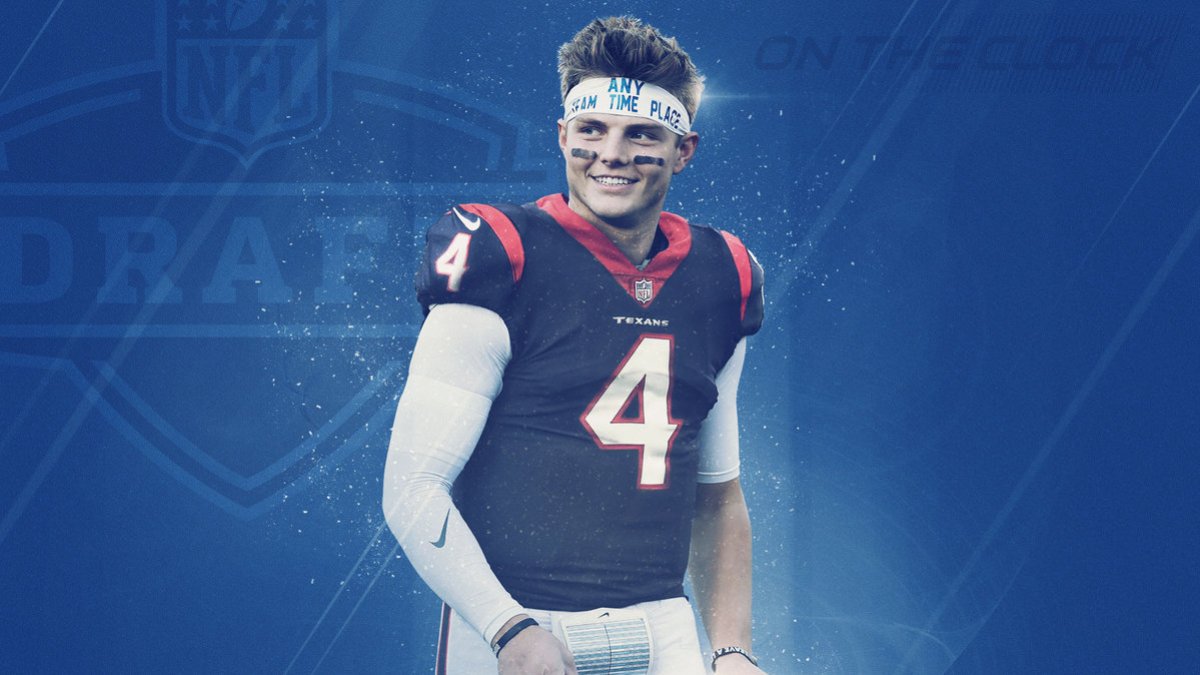


 © 2024 PFF - all rights reserved.
© 2024 PFF - all rights reserved.